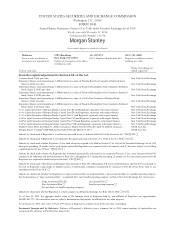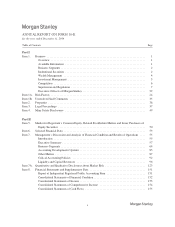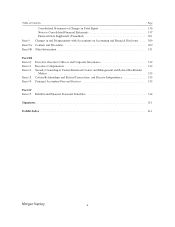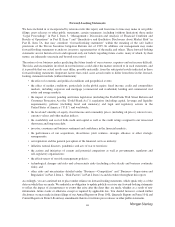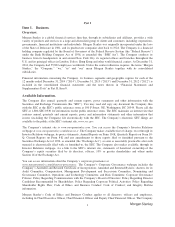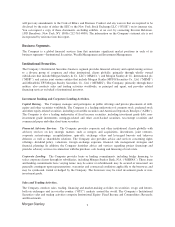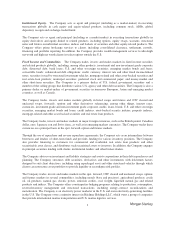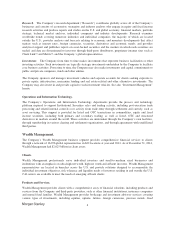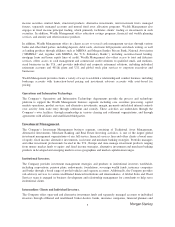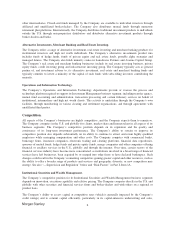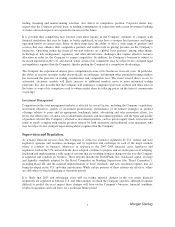Morgan Stanley 2014 Annual Report Download - page 11
Download and view the complete annual report
Please find page 11 of the 2014 Morgan Stanley annual report below. You can navigate through the pages in the report by either clicking on the pages listed below, or by using the keyword search tool below to find specific information within the annual report.
trading, financing and market-making activities, also affects its competitive position. Corporate clients may
request that the Company provide loans or lending commitments in connection with certain investment banking
activities and such requests are expected to increase in the future.
It is possible that competition may become even more intense as the Company continues to compete with
financial institutions that may be larger, or better capitalized, or may have a stronger local presence and longer
operating history in certain areas. Many of these firms have the ability to offer a wide range of products and
services that may enhance their competitive position and could result in pricing pressure on the Company’s
businesses. Operating within the financial services industry on a global basis presents, among other things,
technological, risk management, regulatory and other infrastructure challenges that require effective resource
allocation in order for the Company to remain competitive. In addition, the Company’s business is subject to
increased regulation in the U.S. and abroad, while certain of its competitors may be subject to less stringent legal
and regulatory regimes than the Company, thereby putting the Company at a competitive disadvantage.
The Company has experienced intense price competition in some of its businesses in recent years. In particular,
the ability to execute securities trades electronically on exchanges and through other automated trading markets
has increased the pressure on trading commissions and comparable fees. The trend toward direct access to
automated, electronic markets will likely increase as additional markets move to more automated trading
platforms. It is also possible that the Company will experience competitive pressures in these and other areas in
the future as some of its competitors seek to obtain market share by reducing prices (in the form of commissions
or pricing).
Investment Management.
Competition in the asset management industry is affected by several factors, including the Company’s reputation,
investment objectives, quality of investment professionals, performance of investment strategies or product
offerings relative to peers and an appropriate benchmark index, advertising and sales promotion efforts, fee
levels, the effectiveness of and access to distribution channels and investment pipelines, and the types and quality
of products offered. The Company’s alternative investment products, such as private equity funds, real estate and
funds of funds, compete with similar products offered by both alternative and traditional asset managers, who
may be subject to less stringent legal and regulatory regimes than the Company.
Supervision and Regulation.
As a major financial services firm, the Company is subject to extensive regulation by U.S. federal and state
regulatory agencies and securities exchanges and by regulators and exchanges in each of the major markets
where it conducts its business. Moreover, in response to the 2007–2008 financial crisis, legislators and
regulators, both in the U.S. and worldwide, have adopted, continue to propose and are in the process of adopting,
finalizing and implementing a wide range of reforms that are resulting in major changes to the way the Company
is regulated and conducts its business. These reforms include the Dodd-Frank Act; risk-based capital, leverage
and liquidity standards adopted by the Basel Committee on Banking Supervision (the “Basel Committee”),
including Basel III, and the national implementation of those standards; and new resolution regimes that are
being developed in the U.S. and other jurisdictions. While certain portions of these reforms are effective, others
are still subject to final rulemaking or transition periods.
It is likely that 2015 and subsequent years will see further material changes in the way major financial
institutions are regulated in both the U.S. and other markets in which the Company operates, although it remains
difficult to predict the exact impact these changes will have on the Company’s business, financial condition,
results of operations and cash flows for a particular future period.
7

